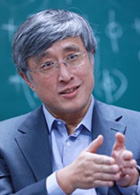

Experimental Observation of Pentaquark States
Abstract:Protons and neutrons are not fundamental particles, instead were formed by quarks. Those thousand particles that made of quarks discovered in cosmic rays or generated in particle accelerators are called hadrons. The quark model succeeds in explaining most of the hadrons so far, which were classified to be either made by quark-antiquark pairs as mesons, or three quarks as baryons. It had been a longstanding question in particle physics whether exotic particles exist like pentaquarks (that is, particles consist of five quarks).
In 2015, an enhancement was observed in the J/ p invariant mass spectrum in the decay of b J/ pK. The first pentaquarks was unveiled by the Dalitz plot and then full amplitude analysis. The China group working on the Large Hadron Collider beauty (LHCb) experiment at the Conseil Europ enn pour la Recherche Nucl aire (CERN) led by Professor Yuanning GAO made significant contribution.
The discovery of pentaquarks is a major breakthrough in understanding the formation of hadrons. Many probabilities exist for the internal structure of the pentaquark, quarks tightly bounded state, baryon-meson molecular state, or the superpositions of these possible quantum states. As one of the frontiers of high energy physics, studying the pentaquark’s properties provides a new way for the exploration of strong interactions.
Awardee:Yuanning GAO is an experimental physicist and professor of particle physics at the School of Physics, Peking University (PKU), and currently serving as Dean of the School, as well as Director of the State Key Laboratory of Nuclear Physics and Technology.
He obtained his Ph. D. degree at PKU in 1989. After working at the Institute of High Energy Physics, Chinese Academy of Sciences, Royal Holloway, University of London, and the University of Wisconsin at Madison as research associate (1989-2000), and Tsinghua University as professor (2000-2018), he joined Peking University in 2018.
Professor GAO focuses on experimental particle physics during the past thirty years. In 1990, he participated in experimental tests of Quantum Chromodynamics on the ALEPH experiment at the Large Electron-Positron Collider located at the CERN (Conseil Europ enn pour la Recherche Nucl aire). He served as the convener of the ALEPH Higgs Task Force group in 1999-2000.
Since 2000, LHCb China Group he organized as founding leader has made significant contributions with high impact in the LHCb collaboration. The discovery of the first pentaquark states which could be an important stepping-stone in our understanding of the strong force was selected as Breakthrough of the Year 2015 by Physics World (Institute of Physics, UK) and Highlights of the Year 2015 by Physics (American Physics Society). The discovery of the first doubly charmed baryon was selected as one of China’s top 10 advances in science in 2017.
GAO was sponsored by the National Science Fund for Distinguished Young Scholars in 2002. In 2019, he was elected as member of Chinese Academy of Sciences.
He served as co-spokesperson (2006-2007) and chair of executive board at Beijing Spectrometer (BESIII) Collaboration (2009-2011). He was also invited to give keynote talks at the International Symposium on Lepton Photon Interactions at High Energies in 2007 and 2017, respectively.